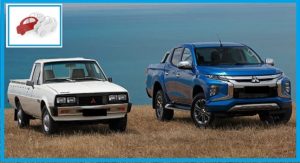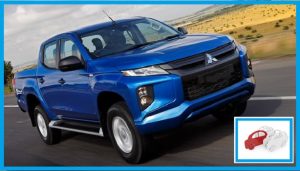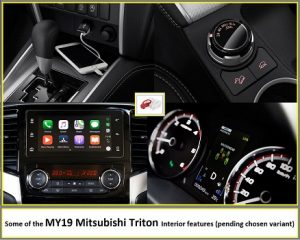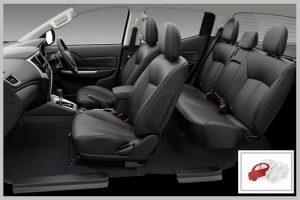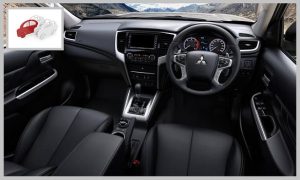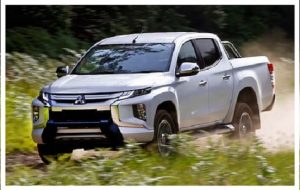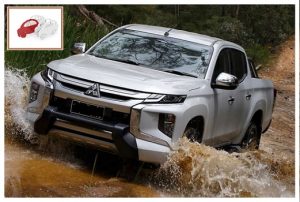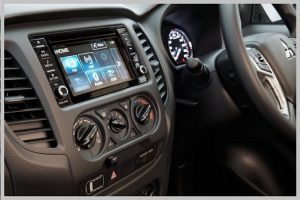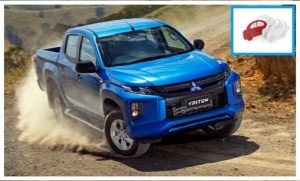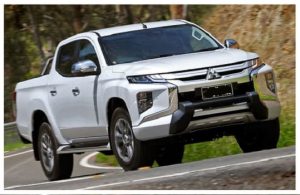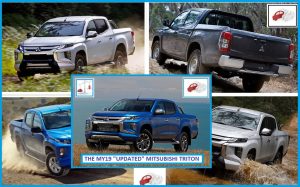Dabas blog July 2019;
Hello readers, hoping your footy team is in one of the eight top spots of the AFL ladder – and still has the original main coach as in game number one of the 2019 AFL season. With the top eight spots in mind – and as mentioned briefly in last month’s DABAS blog post – and whilst responding to a client’s blog-topic request – let’s look more closely at the number three-selling utility amongst Australian buyers so far this year: the MY19 Mitsubishi Triton. Dual-cab utilities are now seemingly replacing the previous generation’s Holden or Ford station wagon as home of the millennials’ last nappy bag or baby booster seat and being used more for the entire family’s transport needs. This makes the included road safety acronyms in a vehicle a priority for potential dual-cab buyers, many of whom were impressed that the MY19 Triton range included a dual-cab utility with AEB included for under $36.5k, which in turn makes the Triton 4×2 dual-cab auto diesel the best-priced ute on the market presently with AEB at $36,290. 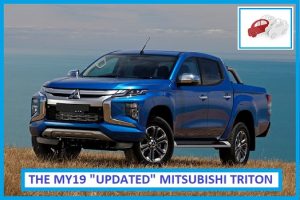
The Mitsubishi Triton has now been available in Australian car dealerships for 41 years; this newly facelifted MY19 Mitsubishi Triton demonstrates just how far the utility market has evolved over those 41 years.
The Mitsubishi Triton, now in its fifth generation – which launched in MY2015 – is now the third most popular dual-cab ute in Australia behind the Toyota Hilux and Ford Ranger. Mitsubishi Motors recently updated its ‘fifth’ generation Triton with a big MY19 upgrade, hoping to attract even more car-buying consumers to the Mitsubishi brand by offering increased safety technology, refinement and added off-road capability. The MY19 Triton is now more car-like to drive than ever with safety and refinement levels unheard of at the release of the very first (L200) Triton available in Australia in 1978. The new MR-series Mitsubishi Triton typifies the expectations of Australia’s one-tonne ute buyers. ….. So, with that in mind – in this DABAS blog post let’s have a general look at the MY19 facelift of the fifth-generation Mitsubishi Triton utility, which may help in your search for a brand-new MY19 vehicle: much more detailed research information, reviews and brochures – plus any special drive-away pricing offers that DABAS is currently aware of on a brand-new MY19 Mitsubishi Triton vehicle – will be provided upon your transition to becoming a DABAS client.
As with any big decision, it’s best to do research before stepping a toe into a LMCT dealership; DABAS can assist by doing this for you, looking at factors such as fuel economy, safety, technology, servicing schedules and costs, plus added extras that may all help in your final purchase decision, as each vehicle’s variant in the model range is usually available with progressing arrays of added inclusions that may suit your personal needs to a tee. Comparing new cars solo by yourself can be very time-consuming, and at times confusing, but with DABAS’s assistance the modest service fee charged for our assistance will have been well worth it when you get behind the wheel of your ideal dream car, knowing the vehicle suits your lifestyle and hip pocket, both now and in the long run!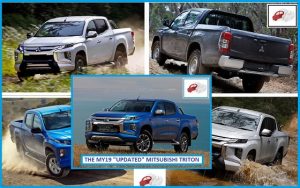
We hope you find this blog post on – the MY19 facelift of the fifth-generation Mitsubishi Triton – an interesting read, whilst shining some light on information that may assist you selecting a suitable vehicle for your personal car-buying needs, providing some useful “very general-in-nature” information to help you on your MY19 vehicle selection. If you would like DABAS’s assistance buying a vehicle, please click here.
Here we go,
The facelifted MY19 Mitsubishi Triton range is powered by the previous MY18 Triton model’s carry-over 2.4-litre petrol and diesel engines, across both the 4×2 and 4×4 model variants. Entry into the Triton range is the MY19 Triton GLX 4×2 single-cab chassis model, priced at *$22,490 (plus on-road costs) *when fitted with Mitsubishi’s 4G64-series 2.4-litre petrol engine and six-speed manual driveline. The Triton range’s top-shelf flagship pick is the Triton GLS Premium 4×4 dual-cab utility at $51,990 powered by a carry-over 4N15-series 2.4-litre turbo-diesel engine and a new Aisin-sourced six-speed automatic transmission. The MY19 Triton range continues to offer single-, club- (extended) and dual-cab (or double-cab) body styles with the choice of both tub and cab chassis styles. There are five variants and a 20-model range to choose from – with updated sharp-look styling across the range, and also offering autonomous emergency braking (AEB) on all but the entry-grade petrol variant. Standard safety kit for the base-grade Triton GLX includes traction and stability control, larger anti-lock disc/drum brakes with hill-start assist, trailer stability assist, a reversing camera and seven airbags. Note – as just mentioned – this MY19 Triton hasn’t yet made the transition to rear disc brakes as some other utes in the segment now have. Triton GLX ADAS and GLX+ variants add autonomous emergency braking (or Forward Collision Mitigation as Mitsubishi calls it ) and lane departure warning, while the Triton GLS and GLS Premium models pick up auto high-beam, lane-change assist, rear cross-traffic alert, blind-spot monitoring and a mis-acceleration system (auto only) that helps you avoid inadvertent low-speed collisions. The Triton GLS Premium is the only model in the range to incorporate a 360-degree camera. When ANCAP tested the Mk5 (fifth-generation) Mitsubishi Triton in 2015, on which this facelifted MY19 model is based, the Triton scored a five-star safety rating.
Mitsubishi’s latest Dynamic Shield design concept gives the MY19 Triton a stylish bold frontal treatment, emphasising a sharp wider look for this facelifted MY19 model. The fog lights and headlights are positioned 700mm higher than the MY18 Triton, putting them even further out of harm’s way during bitumen or off-road 4WD work. The MY19 facelift has more chrome bling than previously in MY18, while the slatted grille and headlights wrap seamlessly into the bonnet and guards, suggesting to the eye it was styled from a single piece of sheet-metal. The higher side-line of the MY19 redesigned tray gives the MY19 Triton a stable look, while the deep rear bumper and square taillights exaggerate the proportions of the tray. The pick-up bed (and alloy drop-side trays on cab/chassis models) are essentially unchanged in terms of area and payload compared to the MY18 model.
The MY19 Triton’s interior draws inspiration from the latest seven-seat Mitsubishi Pajero Sport SUV (which shares its sibling’s DNA origins with the Triton). The dashboard theme combines silver-look garnishes and increased soft-touch materials, which in turn gives the interior a more premium look than previous MY18 Triton models, thus promoting a nice feel and appearance across the range for two, four or five passengers.
The MY19 Triton has good leg-space in the front, and the seats have reportedly good ergonomics. Steering height adjustment is offered across the range, whilst GLX Premium models add electric adjustment and heating for the front seats and leather upholstery. The double cab’s back row is said – by some – to be narrow across the bench; reviews say it’s apparently a better fit for two passengers than three. B-pillar grab handles are included, which come in handy considering the raised height of the side steps.
In the one-tonne ute market, ability and credentials of the four-wheel-drive system are big differentiators. The Mitsubishi ute’s dedicated dual-range mechanical set-up shows 4WD ability that outshines most of its competitors’ helical rear diffs and pseudo low-range gearboxes. The Mitsubishi Triton’s four-mode Super Select II 4WD system (available on higher grade models) is said to be a real advantage for both agricultural and recreational ute buyers plus off-the-bitumen government fleets.
The MY19 Mitsubishi Triton has rear and centre differential locks, plus hill-descent control (adapted from the Pajero Sport), the dual-range gearing augments ground clearance and geometry figures well suited to Australian buyers’ expectations. Mitsubishi quotes 220mm ground clearance on models equipped with 18-inch wheels (the alloy wheels on top-of-the-range Triton models are borrowed from the Pajero Sport), reportedly with approach, ramp-over and departure angles 31, 25 and 23 degrees respectively. The Triton also has a relatively tight turning circle, which is another plus, on the bush tracks – or – in Saturday mornings’ AFL Aus-kick footy carpark. Reportedly, the Mitsubishi double cab’s 11.8m arc is better than every other ute in the class, whilst some reviews say the steering is heavier than some at shopping-centre parking speeds.
Water fording is just 500mm (note: some of Triton’s rivals are now around the 700mm mark). Braked towing capacity is 3100kg. Note – pssst – this is 400kg less than most competitors, though some reports would argue it’s also a more realistic true real-world capacity than some competitors, when considering payload, passenger and tow ball down-weight provisions.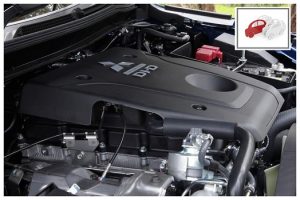
Mitsubishi reports 133kW/430Nm of output from of its diesel engine, whilst the new six-speed auto in the MY19 update has an improved wider ratio spread that disguises much of the 2.4-litre motor’s low-revving character. With the MY19 Triton, a final drive ratio of 3.732:1, bigger body with a chunky aerodynamic profile plus an increased kerb weight (1935kg) – compared to a MY18 Triton – all make the MY19 Triton heavier on fuel that the MY18 model. The diesel model now returns 8.6L/100km on the ADR Combined cycle.
Cabin tech
Depending on the chosen variant, the infotainment array features a 6.1- or 7.0-inch touchscreen accessing Bluetooth for your telephone and its audio streaming, AM/FM and DAB radio, Android Auto and Apple CarPlay, voice control and satellite navigation (via smartphone on some variants). Additional USB ports give double-cab back-seat passengers the chance to charge their phones, while higher-grade models add a Multi Information Display to the instrument panel for extra information. An additional (ceiling-mounted) vent system improves the cabin’s air circulation throughout the double-cab models, drawing air in from the front of the cabin and dispersing it to the rear, rather than channelling the air through centre console-mounted outlets like some of the MY19 Triton rivals. High-grade 2019 Mitsubishi Triton variants get dual-zone climate control, speed-sensitive door locking, LED lighting, electrically adjustable and heated front seats, as well as keyless entry and ignition. The infotainment and connectivity technology offered in the MY19 Triton is much like that found in the MY18 range.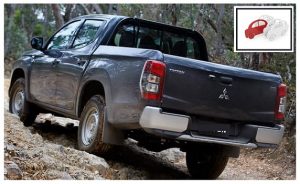
How much does the 2019 Mitsubishi Triton cost?
Price range depends on your chosen variant, ranging from $22,490 to $51,990 (plus on-road costs)
The MY19 Mitsubishi Triton ranges pricing. (plus add the on-road costs)
Single Cab
4X2 GLX Cab Chassis 2.4L Man Petrol @$22,490
4X2 GLX Cab Chassis 2.4L Man Diesel @$25,990
4X2 GLX Cab Chassis 2.4L Auto Diesel @$28,490
4X4 GLX Cab Chassis 2.4L Man Diesel @$32,990
4X4 GLX Cab Chassis 2.4L Auto Diesel @$35,490
Club Cab
4×4 GLX Cab Chassis 2.4L Man Diesel @$35,490
4×4 GLX Cab Chassis 2.4L Man Diesel @$38,790
4×4 GLX+ Cab Chassis 2.4L Man Diesel @$40,490
Dual Cab
4×2 GLX ADAS Pick Up 2.4L Auto Diesel @$36,290
4×4 GLX Cab Chassis 2.4L Man Diesel @$36,240
4×4 GLX ADAS Cab Chassis 2.4L Auto Diesel @$39,540
4×4 GLX 2.4L Pick Up Man Diesel @$37,490
4×4 GLX 2.4L Pick Up Auto Diesel @$39,990
4×4 GLX ADAS 2.4L Pick Up Man Diesel @$38,290
4×4 GLX ADAS 2.4L Pick Up Auto Diesel @$40,790
4×4 GLX+ 2.4L Pick Up Man Diesel @$39,990
4×4 GLX+ 2.4L Pick Up Auto Diesel @$42,490
4×4 GLS 2.4L Pick Up Man Diesel @$44,490
4×4 GLS 2.4L Pick Up Auto Diesel @$46,990
4×4 GLS *Premium 2.4L Pick Up Auto Diesel @$51,990 (*This variant replaces the previous MY18 Exceed)
PS; Keep in mind that DABAS is aware of some LMCT dealers that often have this DABAS blog’s featured vehicle in the yard for keen drive-away pricing well below the RRPs; these prices will be discussed upon your transition to becoming a DABAS client.
Engines in variant levels: 2.4-litre four-cylinder petrol or a 2.4-litre four-cylinder turbo-diesel engine.
Reported power outputs: petrol engine is 94kW/194Nm; / diesel engine is 133kW/430Nm
Transmission choices pending variant chosen: five-speed manual; six-speed manual; six-speed automatic
Reported fuel usage: petrol 10.9L/100km; diesel 8.6L/100km (ADR Combined)
CO2: petrol 254g/km; diesel 185g/km (estimated)
Safety rating: five-star ANCAP (2015)
Warranty – Mitsubishi, for the updated MY19 Triton, introduced a seven-year/150,000km warranty offer until June 30 (2019), which aimed to hopefully introduce and entice ute buyers to the Triton’s new facelifted MY19 range. Reportedly, if you buy after that date the warranty will default to five years. A four-year roadside assist and three-year capped-price servicing scheme are also part of the deal.
In summary of the M19 Mitsubishi Triton, autonomous emergency braking (AEB or Forward Collison Mitigation as Mitsubishi calls it) is standard on all models except the GLX. That makes the $36,290 Triton 4×2 dual-cab auto-diesel the cheapest ute on the market with included AEB at present. The GLX only gets rear parking sensors and then only on the pick-up not the cab chassis. Mitsubishi has introduced a GLX ADAS model to target fleets that includes the rear sensors and adds AEB and lane departure warning. GLX+ gets the same ADAS specification. GLS adds auto high-beam, blind-spot warning, lane change assist, rear cross-traffic alert, front parking sensors and a mis-acceleration system (auto only) that helps you avoid inadvertent low-speed collisions. GLS Premium alone gets a 360-degree camera. All Tritons also get hill-start assist, traction and stability control, trailer stability assist, a reversing camera and seven airbags. Considering the value benefits Mitsubishi continues to offer over its nearest competitors – including a seven-year warranty for a limited time and capped-price servicing for three years or 45,000km – we’re tipping the Triton will continue to sell very well. Depending on how you plan to use it, the Triton is a choice offering to put on your shopping list and one that DABAS thinks has private, fleet, trade, agricultural and recreational buyers in its sights. Psst, FYI– the sixth-generation Triton – due in 2021 and reportedly to be twin-skinned with the Nissan Navara – is once again, a likely candidate for another steep change.
At DABAS we know that buying a car to suit your needs can be one of the biggest purchases in your life. We hope this intended to be “general-in-nature advice and information” blog page has provided some helpful assistance for you in deciding the path of your car-buying journey. Please note any examples, options, pricing and information mentioned in this blog post are to be considered as a very general-in-nature summary; all specifications, information and advice mentioned in this blog page may be outdated or superseded by the time of your reading of this blog page; information in all DABAS blog pages will be confirmed at the time of you updating into your next vehicle, along with your chosen vehicle’s sales representative in their LMCT showroom at the time you transition to becoming a client of DABAS. We look forward to having a chat when the need arises for you to update your car; to assess your personal car-safety requirements and buying needs to suit your lifestyle. And importantly your set specified budget!
Whatever roads your life journey takes you on, DABAS can help you find a car to travel those roads.
When it comes time to update your car DABAS is aware of some things to consider within the many featured model range variants inclusions, plus more of the opposition comparisons, and also things to keep in mind – including when you are trading in your old car at a LMCT used-car yard – and the special trade-in incentives offered on drive-away-no-more-to-pay deals obtainable – at times – within leading brands’ Melbourne LMCT new-car dealerships. These will be discussed upon your transition to becoming a client of DABAS.
To contact DABAS to discuss your car-buying needs; please click here
For information on seven-seater vehicles that tow; please click here
To compare the MY19 Triton range with the MY19 Ford Ranger; please click here
For comparing 10 most popular vehicles “overall sales” in early 2019; please click here
For information on environmentally minded cars; please click here
To see a self-evaluating check list – is it time to update your car; please click here
To see twenty interesting things to consider when buying a car; please click here
To see three things to consider when moving on from your old car; please click here
For comparison of vehicle manufacturers’ warranty periods; please click here
If you would like to go to the car auctions as an alternative car-buying option; please click here
For “many more” DABAS past blog topics (including towing and tyre safety tips); see our archived index
For a step-by-step example of a DABAS car-buying journey; please click here
Thanks for visiting DABAS’s website and blog; Have a great day, Cheers, Tim.
Please note; information mentioned on this page is to be considered as a general-in-nature summary; all information and advice mentioned may be outdated or superseded by the time of your reading of this page; all information will be confirmed at the time of your transition to becoming a client of DABAS.


